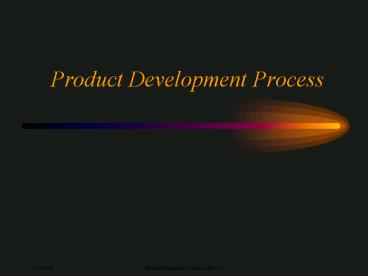Product Development Process PowerPoint PPT Presentation
1 / 21
Title: Product Development Process
1
Product Development Process
2
Product Development Process
A
is the entire set of activities required to
bring a new concept to a state of market
readiness.
product development process
3
Product Design Process
- Understanding the Opportunity
4
Understanding the Opportunity
Characterized with four activities
- Develop a vision
- Market opportunity analysis
- Customer/user need analysis
- Competitive products analysis
5
Develop a vision
The first step in product development is to have
a vision.
What product do we like to be out there?
Why does it not do something we want it to?
What is difficult with the current product we use?
6
Develop a vision
Visions are a dime a dozen
- Every user has thoughts on how they wish their
device would work. - Every research scientist has a vision for how
their technology can be applied. - Every manager has a vision for command of a
market.
The question is whether any vision can be
transformed into a successful realization. Can it
be developed and implemented into a profitable
product?
7
Market opportunity analysis
Go/No-Go decision on a new product
- S-Curves
- Technical questioning
- Mission statement
- Product development economic analysis
8
Determining What to Develop
- Should a completely new product be designed
(original design or invention)? - Should the existing product be redefined and
modified to better satisfy the customer (adaptive
design, evolving a known design)? - Should the product be expanded to variant forms
to more comprehensively cover the market (variant
design involves varying parameters, size, shape,
materials,. )?
9
S-Curves
Technological innovations typically manifest
themselves into a market along an S-curve
timeline behavior.
The S-curve displays the performance of a product
over time with respect to one variable.
Stage I - characterized by relatively low
performance, not much innovation. Stage II
rapid growth due to many innovations, many
products introduced into the market. Stage III
technology tops out, product may become obsolete
10
Comments on S-Curves
- S-Curves show the market behavior of most
technologies - A switch to a better technology is known as
jumping the S-curve. - The newer s-curve is a disruptive technology that
requires changes in the market system to succeed
(VHS, DVD, HDTV, .) - The industry is constantly jumping the S-curve
- Design team should consider the technology
environment in introducing new product.
11
Comments on S-Curves and Technology Forecasting
Although most technologies follow this path of
market behavior, there are exceptions. Moores
Law (transistor density on microprocessors
doubles every 18 months).
12
Technical Questioning and Mission Statement
13
Any new product development project faces risk
from two independent sources.
Product development Risks
- Is the product technically feasible? Can we make
it in a reasonable time? - Is the product economically feasible? Will people
buy it at a reasonable profit to us?
Technical Questioning and Mission Statement are
two processes used to answer these questions.
14
Technical Questions
- Technical questions are needed to clarify the
task. - To keep focus, one should question the current
understanding of the development. - Questions should be asked and answered, not once,
but continually through the life cycle of the
design process.
15
Example Design a new fingernail
clipperExisting fingernail clippers in the
market
16
Technical Questioning fingernail clipper example
- What is the problem really about?
- Clumsy operation of a typical clipper, nail
clippings all over - What implicit expectations and desires are
involved? - Remain a manual clipper that can be operated by
oneself, collect clippings, . - Are customer needs, requirements, and constraints
truly appropriate? - Consumer studies have noted clumsy operation. A
detailed assessment will be made post-consumer
interviews - What avenues are open for creative design?
- Can modify any and all parts, use different
materials besides metals. Add functionality, such
as the ability to store and dump nail debris
17
Technical Questioning fingernail clipper example
- What avenues are limited for creative design?
- No electrical power, size, weight, cost
- What characteristic/properties must the product
have? - Durable, safe, easy to use
- What characteristic/properties must the product
not have? - Should not be heavy and bulky
- What are the technical conflicts inherit in the
design task? - Compact size vs. large surface area for grasping
and large mechanical advantage.
18
Technical Questioning fingernail clipper example
- What aspects of the design task should be
quantified now?
Customer needs analysis, fingernail
characteristics size and strength, human hand
and finger size and strength, required profit to
cover development cost. Research, estimates and
simple calculations should be performed to
understand these issues.
19
Mission Statement
The tangible result of the technical questioning
should be a precise and clear statement of the
design teams mission. Also called, Product
Plan, Market Attack Plan, Vision Statement
20
Mission Statement Template
21
Mission Statement Example

